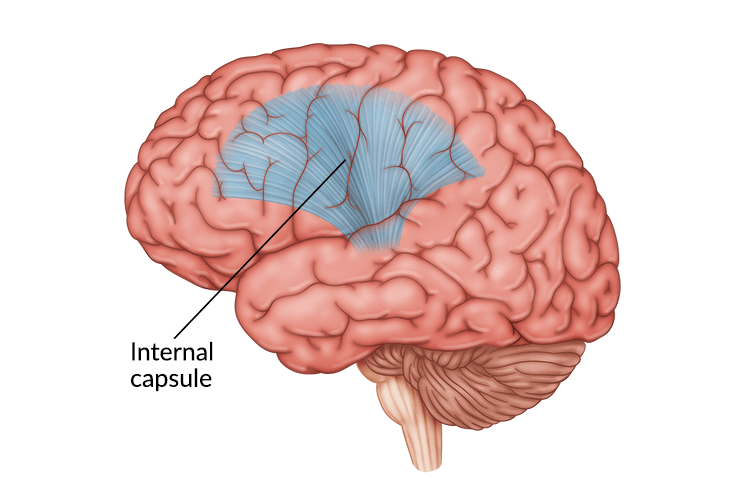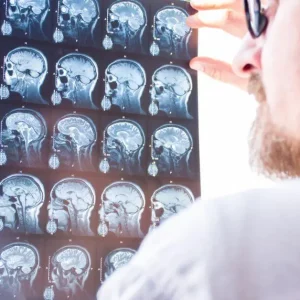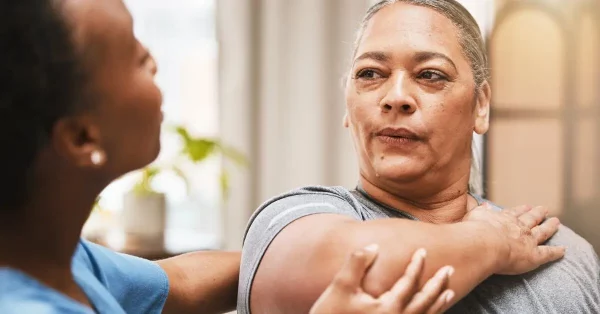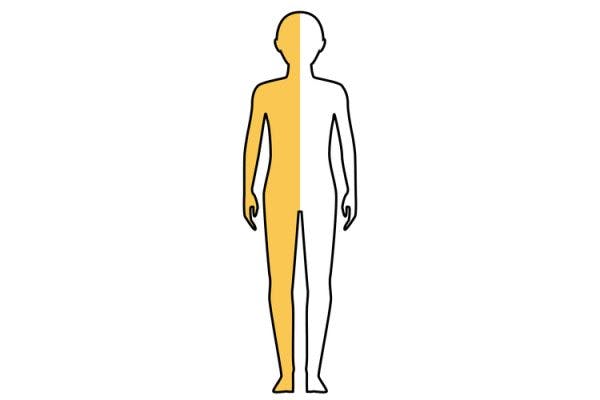An internal capsule stroke affects the tiny blood vessels deep within the brain. The internal capsule has a unique function, as many crucial fibers pass through this area of the brain. Therefore, even a small stroke in this area can result in a significant loss of motor control, sensation, or cognition. Fortunately, there are effective ways to recover functions affected by internal capsule stroke and improve your quality of life.
To help you better understand what to expect after an internal capsule stroke, this article will begin by discussing the anatomy of this area of the brain. Then we will review common secondary effects and rehabilitation options after a stroke in the internal capsule. Feel free to use the jump links below to help navigate this article:
- Anatomy of the internal capsule
- Effects of internal capsule stroke
- Recovery after internal capsule stroke
Anatomy of the Internal Capsule
The internal capsule is a V-shaped structure located deep within the brain. This structure is made of nerve fibers that facilitate communication. Many motor, sensory, and cognitive fibers run through the internal capsule as they travel between the cerebral cortex (the brain’s outer layer) and the brainstem (the lower area that connects to the spinal cord). The internal capsule also connects cortical structures to the deeper subcortical structures of the brain, such as the hypothalamus.
The brain is divided into two hemispheres, or halves, and both hemispheres have an internal capsule. Each hemisphere generally controls functions on the opposite side of the body. As a result, damage to the left internal capsule typically affects the right side of your body while damage to the right internal capsule affects the left side of your body. Motor control, sensation, and cognitive function can be affected because of the internal capsule’s involvement in so many diverse connections.
Different fibers run through the various regions of the internal capsule, each controlling different functions. Therefore, the effects of an internal capsule stroke depend on which areas were affected. The following section will discuss the potential effects of an internal capsule stroke and how damage in specific areas can affect functional outcomes.
Secondary Effects of Internal Capsule Stroke
A stroke occurs when blood flow to the brain is compromised, causing cell death and tissue damage. This takes place when an artery in the brain becomes blocked (ischemic stroke) or bursts (hemorrhagic stroke). The arteries in the internal capsule are very small, which increases the likelihood of clotting that can lead to a stroke. Additionally, these delicate arteries are susceptible to rupture, which causes bleeding deep within the brain.
When the small perforating arteries that feed deep brain structures like the internal capsule become blocked, this is called a lacunar stroke. This type of ischemic stroke can cause a variety of symptoms but often leads to a pure motor stroke, meaning only motor functions are affected. Thankfully, a lacunar stroke is often small due to the small size of the affected vessels. As a result, individuals can have mild symptoms or be asymptomatic. However, this is not always the case.
Blood is rich in oxygen and other essential nutrients that fuel brain activity. When blood supply is compromised, brain cells start to die. This can affect various sensory, motor, and cognitive functions depending on the specific areas affected. Unfortunately, brain cells that have died are unable to repair themselves or regenerate. However, through the brain’s ability to utilize neuroplasticity, functions affected by an internal capsule stroke may be recovered. Let’s review some of the secondary effects that may occur after an internal capsule stroke.
1. Pure Motor Stroke
When the posterior limb of the internal capsule is affected by stroke, it generally impacts movement and coordination. The most common effect of internal capsule strokes is pure motor stroke, presenting as hemiplegia. Hemiplegia refers to paralysis of one side of the body, resulting in strictly movement-related effects on the affected side. With internal capsule strokes, hemiplegia is generally proportionate, meaning that it affects the face, arms, and legs equally.
In some cases, the affected side may not be completely paralyzed and you may retain some strength or function. This is referred to as hemiparesis, or weakness of one half of the body. While similar, hemiparesis is less severe than hemiplegia and you will likely retain some function of the affected limbs. In some cases, internal capsule stroke can cause ataxic hemiparesis, which refers to weakness combined with clumsiness or poor coordination.
2. Facial Weakness
The muscles of the face and neck are controlled by an area of the internal capsule called the genu. Damage to this area can affect functions like speaking, chewing, and swallowing. As a result, individuals may have difficulty with eating or swallowing, which is known as dysphagia. Additionally, some survivors may struggle with motor speech disorders such as dysarthria after internal capsule stroke.
3. Cognitive Impairments
The anterior limb of the internal capsule contributes to various cognitive functions. As a result, a stroke in the arteries that supply the anterior limb may lead to changes in cognition and higher-level functions. For example, an internal capsule stroke can result in:
- Confusion
- Changes in memory
- Impaired attention
- Agitation
- Speech disorders, such as apraxia of speech
Survivors of internal capsule stroke with anterior limb damage will likely experience cognitive fatigue (mental exhaustion) because the brain must work harder to concentrate. This can result in behavioral changes like increased agitation or confusion. While behavior changes such as agitation often resolve in the first few months after stroke, some changes may persist beyond this period.
4. Sensory Loss
Somatosensory fibers run through the posterior limb of the internal capsule. Therefore, damage to this area due to internal capsule stroke can result in the loss of sensation on the opposite side of the body. Sensory impairments are often reported in the form of heaviness, numbness, or loss of tactile sensation. While less common than pure motor strokes, around 20% of internal capsule strokes are sensory-motor in nature.
5. Hearing Impairments
Your hearing is partly controlled by an area of the internal capsule called the sublenticular segment. This area of the brain transmits auditory signals from the thalamus to the auditory cortex. When an internal capsule stroke affects this area, the survivor may experience hearing impairments.
6. Visual Impairments
An area of the internal capsule called the retrolenticular segment helps to control some of your visual functions. When this area of the brain is affected by stroke, the survivor may experience visual impairments. These visual disturbances can include hemianopia (losing half your visual field) and quadrantanopia (losing a quarter of your visual field).
7. Spasticity
When neural fibers in the internal capsule become interrupted due to stroke, this can cause miscommunication between the brain and muscles. As a result, some survivors may experience overactivity of the muscles which leads to involuntary contraction or spasms. This is known as spasticity and can significantly impact a survivor’s daily function.
Recovery After Internal Capsule Stroke
Every internal capsule stroke is unique and requires a personalized approach to rehabilitation that targets your specific deficits. Participating in rehabilitation therapies can help stroke survivors identify which functions need to be developed. Then you can learn effective exercises or activities from your therapy team to improve those functions. To help you understand what stroke recovery may entail, let’s review some rehabilitation therapies you might encounter.
Rehabilitation Therapies:
- Physical Therapy. Survivors who experience movement impairments after stroke will benefit from working with a physical therapist. Physical therapy helps individuals improve motor functions through targeted exercise. This can help survivors gain range of motion, muscle strength, coordination, and functional mobility. Additionally, physical therapists can address other complications such as spasticity or contractures.
- Speech Therapy. If your stroke results in facial weakness, speech therapy can help. A speech-language pathologist will guide you through exercises designed to strengthen the oral motor muscles so you can speak more effectively. Additionally, speech therapists can help you overcome dysphagia and provide cognitive rehab exercises to improve memory.
- Occupational Therapy. The effects of an internal capsule stroke may contribute to difficulty engaging in your activities of daily living. This includes everyday tasks such as dressing, bathing, and toileting. If this is the case, occupational therapy can help you learn new ways to perform these activities to regain some of your independence. Additionally, an occupational therapist can help you increase arm function and fine motor control and can also recommend appropriate adaptive equipment.
- Sensory Reeducation. To restore sensation, stroke survivors can work on sensory reeducation exercises with an occupational therapist. These exercises help you encourage your brain to relearn sensory processing skills for properties like texture and temperature. Talk with your occupational therapist to come up with a treatment plan that is specific to your needs and abilities.
- Vision Training. If you’re experiencing visual field cuts after stroke, consider vision training. This therapy involves stimulating your vision with different exercises based on your unique needs.
Hope Through Neuroplasticity
Promoting neuroplasticity is the most effective way to recover after an internal capsule stroke. Neuroplasticity is the brain’s ability to rewire its neural circuitry through the rebuilding of neural connections. This rebuilding allows functions affected by stroke to be reorganized and improved, but this takes considerable effort, time, and patience.
Consistently practicing the exercises provided by your therapy team will reinforce the demand for those functions and encourage adaptive changes in your brain. The more you practice, the stronger these new connections become. Work closely with your therapy team to develop a home exercise program that enables you to reach your goals after stroke. Then, continue stimulating your brain to make adaptive changes, even outside of your rehabilitation sessions.
Understanding Internal Capsule Stroke
The internal capsule is a deep brain structure that plays a unique role in your brain’s communication system. The blood vessels in the internal capsule are small and therefore susceptible to clotting or bursting, which can cause a stroke. Depending on the severity and specific location of the internal capsule stroke, various motor, sensory, and cognitive functions may be affected.
Some possible secondary effects of internal capsule stroke include hemiplegia, reduced sensation, cognitive changes, and visual disturbance. In many cases, injury to this area of the brain results in a pure motor stroke, meaning symptoms are solely motor-related. Thankfully, by stimulating the brain and promoting neuroplasticity, any function affected by stroke has the potential to be improved.
Repetitive, task-specific practice is the foundation of a great rehabilitation program. By working together with your therapists, you can create a plan that is individualized to your unique abilities. Then, keep taking steps each day to reach the goals you set for yourself. Even after internal capsule stroke, you can increase your independence and get back to doing the things you love.















